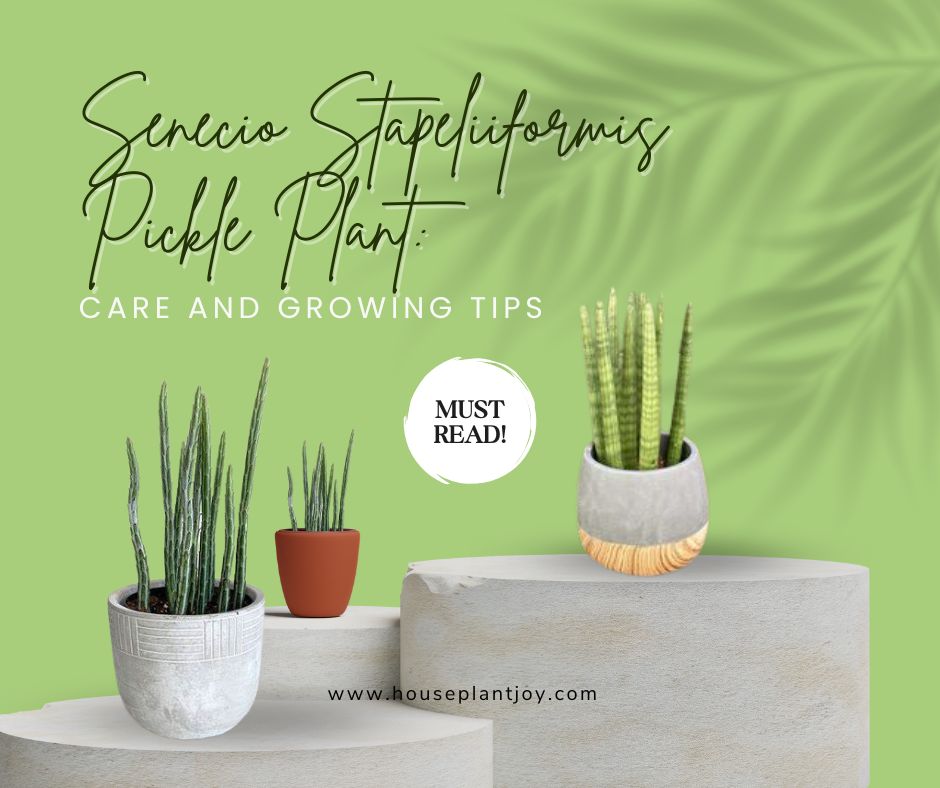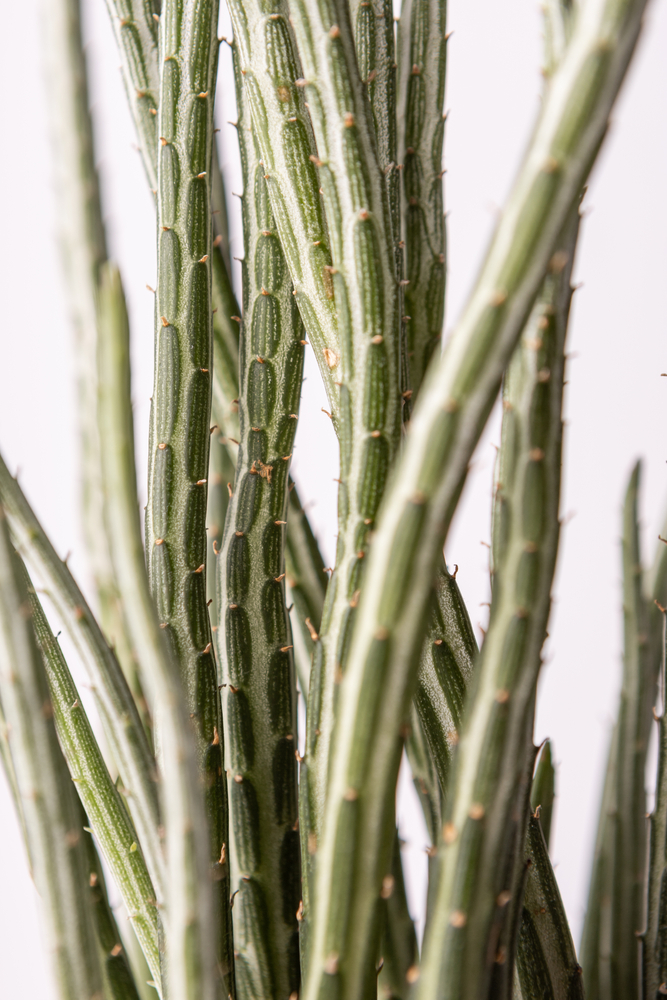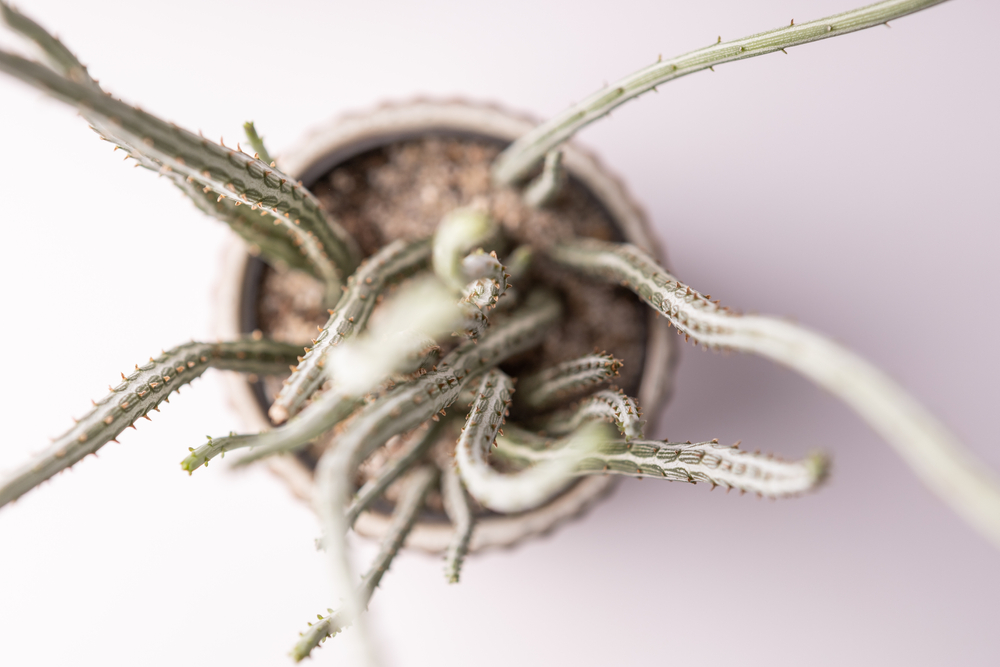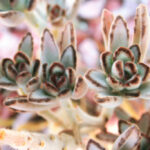HousePlantJoy is supported by our audience. When you purchase through one of our links, we may earn a small affiliate commission. As an Amazon Associate I earn from qualifying purchases. Your cost is not affected.
==================
Senecio Stapeliiformis Pickle Plant: Essential Care and Growing Tips
Senecio Stapeliiformis, or Kleinia Stapeliiformis or the Pickle Plant, is a unique and attractive succulent perennial native to South Africa. Its distinctive pencil-shaped stems feature soft spines and eye-catching purple-green patterns, making it a popular choice for succulent enthusiasts and gardeners. This drought-tolerant plant is easy to care for, and its intriguing appearance adds an exotic touch to any home or garden.
The growth and propagation of Senecio Stapeliiformis are pretty straightforward, making it an ideal plant for beginners and experienced gardeners alike. As with most succulents, it requires well-draining soil and moderate watering to thrive. Adequate sunlight is also crucial for this plant, with at least 3-4 hours of direct sun exposure daily, ensuring its stunning colors and patterns remain vibrant.
Key Takeaways
- Senecio Stapeliiformis is a unique succulent native to South Africa with distinctive pencil-shaped stems and soft spines.
- Easy to care for, this drought-tolerant plant requires well-draining soil, moderate watering, and adequate sunlight or bright indirect light to thrive.
- Pickle Plants are an attractive addition to any home or garden, ideal for beginner and experienced gardeners.
Origins and Natural Habitat
The Senecio Stapeliiformis, commonly known as the Pickle Plant, is a unique and attractive succulent that originates from South Africa. Particularly, it belongs to the Eastern Cape Province region. Belonging to the Asteraceae family, this plant showcases striking pencil-like stems with purple-green patterns and soft spines along its sides 1.
Pickle Plants are native to a dry and arid environment, which explains its resilient and drought-tolerant nature. South Africa’s Eastern Cape, where Pickle Plants thrive, is a region known for its semi-desert areas and diverse climates. This natural habitat greatly influences the plant’s low-maintenance requirements and ability to adapt to various indoor conditions 2.
There are two known subspecies of the Senecio Stapeliiformis: ssp. stapeliiformis (native to Eastern Cape Province, South Africa) and ssp. minor (also found in Kenya and Tanzania) 3. When growing your Pickle Plant, it’s essential to recreate the conditions similar to its native environment to ensure good health and growth.
As a confident and knowledgeable gardener, it’s crucial to understand your plant’s origins and natural habitat to provide the best care possible. Familiarize yourself with the ideal temperature ranges, watering practices, and soil composition for your Pickle Plant succulent, drawing inspiration from its natural habitat in South Africa’s Eastern Cape. By doing so, you’ll give your Pickle Plants a strong foundation to thrive in your home or garden.
Scientific Classification
The Senecio Stapeliiformis, also known as the Pickle Plant, is a unique and intriguing succulent species. Its pencil-shaped stems with soft spines and purple-green patterns make it an attractive addition to any succulent garden.
Pickle Plants belong to the Asteraceae family, which is also commonly known as the aster, daisy, or sunflower family. This large and diverse family includes more than 32,000 accepted species, showcasing a wide range of plant types and appearances. Within the Asteraceae family, Pickle Plants are a member of the Senecioneae tribe. This tribe consists of around 1,500 species and is renowned for its chemical diversity, which naturally also extends to the Pickle Plant succulent.
Pickle Plant Succulents
As a succulent, the Senecio Stapeliiformis has adapted wonderfully to its native South African habitat, being drought-tolerant and capable of thriving in well-draining soils. This plant is not only limited to South Africa, as it has made its way into the hearts of succulent enthusiasts worldwide.
In summary, the Pickle Plant (Senecio Stapeliiformis) is an eye-catching succulent species that belongs to the vast Asteraceae family and the diverse Senecioneae tribe. Its unique and captivating pencil-like stems make it an excellent addition to any garden or collection. With its ability to adapt to various climates and conditions, you can confidently grow and appreciate this striking plant.
Plant Features
Senecio Stapeliiformis Pickle Plant succulent feature a striking plant that boasts a variety of unique characteristics, making it an eye-catching addition to any garden or indoor setting. Not only does it look remarkable, but it is also an easy-to-grow plant that requires minimal care.
One of the most noticeable features is its cylindrical, pencil-like stems, which can grow up to 10 inches long. These fleshy, bluish-green stems, often seen cascading from pots, give the plant its nickname – Pickle Plant. The stems are adorned with intriguing purple-green patterns and lined with soft spines along the sides, adding an exciting texture to the overall appearance.
In addition to its unique coloration and patterns, the soft spines surrounding the stems serve as a further point of interest. These spines not only add a touch of elegance to the plant but also play a role in providing it with protection from potential predators or harsh environmental conditions.
You may find that, over time, Senecio Stapeliiformis Pickle Plants become almost fleshy in texture, giving it a pleasant sensation when touched. This fleshy attribute and the cascading growth habit make this plant perfect for filling in spaces in rock gardens, container arrangements, or as an intriguing groundcover in outdoor settings.
In summary, the Senecio Stapeliiformis Pickle Plant succulent is revered for its captivating features, such as cylindrical, pencil-like stems with purple-green patterns, soft spines, and a fleshy, cascading appearance. By incorporating this confident and unique succulent into your plant collection, you can effortlessly elevate the aesthetic appeal of your space while enjoying its low-maintenance care requirements.
Growth and Propagation
The Senecio Stapeliiformis Pickle Plant is an interesting succulent that can be easily propagated and cared for, as long as you provide the right conditions.
Pickle Plant Propagation
To propagate your Pickle Plant, you can use stem cuttings. In order to do so, ensure that you take a healthy cutting with two to three inches in length. Allow the cutting to dry and callous. After a few days or a week, you can plant the cutting in a well-draining soil mix. When planting cuttings, water your new plant lightly and then avoid regular watering until new growth is visible.
It is also possible to propagate Senecio Stapeliiformis from seeds, but this method is less commonly used and can be more challenging. If you choose this method, plant the seeds in a moist, well-draining soil mix. Provide ample light and maintain a consistent temperature to ensure proper germination.
Transplanting
Transplanting your Pickle Plant may become necessary if it outgrows its current container or if you wish to move it to a more suitable location. When transplanting, choose a larger container with drainage holes and fill it with a suitable soil mixture, such as a combination of potting mix, perlite, and coarse sand. Gently remove the plant from its current container, taking care to not disturb the roots. Place it in the new container, filling in the sides with additional soil as needed.
During the growing season, which typically lasts from spring to fall, it is essential to provide your Pickle Plant with the proper care. Ensure that it gets adequate sunlight, at least 3 or 4 hours of direct access each day, with some partial shade during peak temperatures. To maintain optimum growth, also make sure to provide your plant with proper watering and nutrients.
Overall, by following these growth and propagation guidelines tailored specifically to the Senecio Stapeliiformis Pickle Plant, you will be able to enjoy this unique succulent and even share it with friends and family through propagation.
Light and Temperature Requirements
When it comes to light requirements for your Senecio Stapeliiformis Pickle Plant, it thrives in full sun but can also handle partial shade. Providing a good balance of sun exposure allows the plant to grow its best. Make sure to position the plant in an area where it can receive adequate sunlight throughout the day.
Regarding temperature, Senecio Stapeliiformis is suitable for USDA hardiness zones 9 to 11. It prefers temperatures between 65 and 85 degrees Fahrenheit, with a relative humidity of 40 to 50 percent. It’s important to maintain consistent temperatures within this range for optimal growth and health.
Pickle Plant Outdoors
Interestingly, this succulent withstands brief periods of frosting conditions, ranging between 10 and 15°C. However, keeping your plant within its ideal temperature range for sustained growth and to prevent any potential damage is always best.
To ensure your Pickle Plant grows strong and healthy, pay careful attention to its light and temperature needs. By providing the right balance of sunlight and maintaining appropriate temperatures, you’ll create an ideal environment for your plant to thrive.
Soil and Watering
When it comes to the soil for your Senecio Stapeliiformis Pickle Plant, it is crucial to select a well-draining potting mix. Opting for a combination of sandy soil, perlite, or pumice can help provide the necessary drainage for your succulent. The ideal soil mix should consist of equal parts potting soil, sand, and perlite or pumice. This type of soil mix ensures that the water drains quickly and does not cause root rot.
In terms of soil pH, your Pickle Plant prefers a neutral to slightly acidic environment. Aim for a soil pH between 6.0 and 7.0 to keep your plant healthy. It is essential to monitor the pH of the soil, as too high or low pH levels can lead to nutrient deficiencies and hinder plant growth.
Watering plays a significant role in maintaining your Pickle Plant’s overall health. It’s essential to follow a balanced watering schedule and not overwater your succulent. Make sure the soil is completely dry before watering again. During the growing season, typically in spring and summer, you may need to water your plant more frequently. However, as the temperature drops and the plant goes dormant in fall and winter, reduce your watering frequency.
Remember that your Senecio Stapeliiformis is a drought-tolerant succulent and can handle periods of dryness better than excess moisture. A useful rule of thumb is to water deeply but infrequently, allowing the soil to dry out between waterings. This approach helps to promote healthy root growth and prevent root rot issues.
By providing your Pickle Plant with the appropriate soil mix and carefully monitoring your watering practices, you can ensure that your succulent thrives and showcases its unique appearance in your garden or home.
Fertilization
To ensure your Senecio Stapeliiformis Pickle Plant thrives, proper fertilization is essential. In general, succulents such as the Pickle Plant have low nutrient requirements. However, during the growing season, you’ll want to provide them with a well-balanced fertilizer to promote optimal growth.
Begin the fertilization process by selecting a suitable fertilizer that has a balanced N-P-K ratio. It’s preferable to use a liquid fertilizer, as this allows you to easily control the amount and frequency of application. Dilute the fertilizer according to the package instructions to avoid over-fertilizing your plant, which can lead to negative effects, such as root burn.
Fertilize your Pickle Plant once a month during the growing season, which typically runs from spring to late summer. When applying the liquid fertilizer, water your plant first to ensure even distribution of nutrients and avoid over-concentration around the roots. At this time, it’s essential to closely monitor the condition of your plant and make any necessary adjustments based on its growth and appearance.
It’s crucial to reduce the frequency of fertilization during the dormant season. In fact, you should cease fertilization entirely during the winter months, as this is when your Pickle Plant is not actively growing and has reduced nutrient requirements. Resuming fertilization in the springtime will help kickstart the plant’s growth once again.
By following these guidelines and adjusting them to the specific needs of your Senecio Stapeliiformis Pickle Plant, you can maintain its health and ensure its vibrant foliage and unique pencil-shaped stems flourish.
Common Varieties and Similar Species
Senecio Stapeliiformis, or the Pickle Plant, is a unique succulent with distinct pencil-shaped stems, soft spines, and purple-green patterns. If you’re interested in growing succulents, you might also consider some related species and varieties with similar characteristics.
Trailing Jade (Senecio jacobsenii) is a close relative of the Pickle Plant, featuring cascading, fleshy leaves that resemble those of a jade plant. Its trailing habit makes it an excellent choice for hanging baskets or as a groundcover. Grow trailing jade in well-draining soil and bright light.
The popular Spider Plant (Chlorophytum comosum) is not a succulent but offers unique, attractive foliage with long, slender leaves that resemble the legs of a spider. It’s an adaptable, low-maintenance houseplant that can tolerate a wide range of light conditions.
Cactus and cacti plants are also worth considering for your succulent collection. Stapelia, a genus of succulent plants, is noteworthy for its unusual, star-shaped flowers that often emit a strong scent to attract pollinators. These plants thrive in well-draining soil and need plenty of sunlight or bright indirect light.
Another option is the Senecio mandraliscae, commonly known as blue finger or blue chalk sticks. This bushy Senecio has bluish-green leaves that can grow up to 6 inches long. Suitable for full sun to light shade, it can reach a height of 18 inches and a 24-inch spread at maturity.
Lastly, Cylindrical Snake Plants (Sansevieria cylindrica) are a great choice for those who want a low-maintenance, hardy succulent. With vertically-growing, tubular leaves, this distinctive plant can thrive in a range of light conditions and requires minimal watering.
When choosing from these varieties and similar species, consider your specific growing conditions and preferences. With proper care, any of these plants can be a valuable addition to your succulent collection.
Gardening and Landscape Design
Senecio Stapeliiformis, also known as the Pickle Plant, is a versatile and attractive perennial that suits various gardening and landscape designs. This succulent plant is an excellent choice for incorporating into your garden, patio containers, or even as a houseplant. Its unique bluish-green pencil-like stems and soft spines along the sides will add visual interest to your space.
In your garden, the Pickle Plant works well as a succulent ground cover, spreading out its fleshy stems along the soil. When grown in containers, you can place them outdoors on your patio or bring it inside to brighten up your home as a houseplant. This adaptable plant thrives both outdoors and indoors, provided it receives ample sunlight and well-draining soil.
Hanging Baskets
Hanging baskets are another option for showcasing your Pickle Plant. The stems of the plant can spill over the edges of the basket, creating a cascading effect that catches the eye. Remember to place your hanging basket in a location where it will receive sufficient sunlight, as the Pickle Plant prefers at least 3 or 4 hours of direct sun exposure every day.
To ensure your Pickle Plant remains healthy and vigorous, maintain a well-draining soil mix, and do not overwater. As a succulent, it is more tolerant of drought than excessive moisture, so be cautious when watering. Additionally, remember that Pickle Plants are perennial, meaning they will return year after year with the proper care.
In summary, incorporating the Senecio Stapeliiformis Pickle Plant into your gardening and landscape design offers versatility, visual appeal, and low maintenance. From garden landscapes and container gardening on your patio to houseplants and hanging baskets, this unique succulent is a delightful addition to any space.
Pests and Problems
Senecio Stapeliiformis, or the Pickle Plant, is a resilient and low-maintenance succulent plant. However, it’s not entirely immune to pests and problems. In this section, you’ll learn about common pests and how to deal with them to keep your Pickle Plant healthy.
Mealybugs are a common pest that can infest your Pickle Plant. They appear as white, cottony clusters on the plant and can cause yellowing and stunted growth. To address a mealybug infestation, use isopropyl alcohol on a cotton swab or a toothbrush. Gently remove them from the affected area and dispose of them. In case of severe infestations, it might be necessary to use a systemic insecticide.
Another potential pest is the inchworm. Inchworms are small green caterpillars that cause damage by feeding on the leaves and stems of your Pickle Plant. To combat these pests, manually remove them. Alternatively, use biological controls, such as introducing beneficial insects like ladybugs and lacewings into your garden. Another option is to apply a Bacillus thuringiensis (Bt) based pesticide. This effectively targets inchworms without harming other beneficial insects or plants.
Apart from pests, your Pickle Plant might also experience problems due to poor growing conditions. Be sure to provide the plant with adequate light and well-draining soil. This helps prevent issues like root rot and fungal infections. Overwatering is another common problem, as it can lead to rotting and the plant’s eventual death. To avoid this, allow the soil to dry out between waterings, and always use a container with drainage holes.
By keeping an eye out for pests, such as mealybugs and inchworms, and maintaining the right growing conditions, you’ll be able to keep your Senecio Stapeliiformis Pickle Plant thriving and problem-free.
Special Care Instructions
When it comes to the maintenance of your Senecio Stapeliiformis Pickle Plant, there are a few care instructions needed. These help insure it thrives. This succulent plant is quite hardy, but requires some attention to stay healthy and happy.
Firstly, it’s important to provide your Pickle Plant with a suitable light environment. These succulents prefer a combination of direct sunlight and partial shade. Aim to give your plant at least 3 or 4 hours of direct sunlight each day, adjusting as needed during the hotter months to protect it from excessive heat.
Avoid Overwatering
When it comes to water, the Pickle Plant is a drought-tolerant species. This means that you should allow the soil to dry out completely between waterings. Overwatering can quickly lead to root rot, so be attentive to your plant’s needs.
The soil is another important aspect of your Pickle Plant’s care. Make sure to use a well-draining soil mix. This will help avoid standing water and keep the rhizomes healthy.
In terms of grooming and maintenance, you will want to regularly inspect your Pickle Plant for any signs of pests or diseases. Remove any affected parts promptly to prevent the issue from spreading. Pruning may be necessary to maintain a balanced shape and promote healthy growth.
Easy Care
To summarize, the essential care instructions for your Senecio Stapeliiformis Pickle Plant include providing a mix of direct sunlight and partial shade, using a well-draining soil, monitoring its watering needs, and attending to its grooming and maintenance. By following these steps, your Pickle Plant is sure to flourish.
Embrace the Pickle Plant: A Unique and Satisfying Green Companion
Caring for and growing Senecio Stapeliiformis, the delightful Pickle Plant, is a rewarding and enjoyable experience. With its unique appearance and easy-going nature, it’s a fantastic addition to any plant collection. By following the essential care tips discussed in this article, you’ll be well on your way to cultivating a thriving and flourishing Pickle Plant.
Remember, each plant is different, and it’s essential to observe and adjust your care routine accordingly. As you develop a deeper understanding of your Pickle Plant’s needs, you’ll forge a special connection with this fascinating succulent. So, let your green thumb flourish, and embrace the joy of tending to this charming and peculiar Senecio Stapeliiformis. Happy gardening!
Frequently Asked Questions
How to care for a pickle plant?
To care for your pickle plant, make sure it gets at least 3 or 4 hours of direct sunlight each day and keep it in well-draining soil. Provide water when the soil is completely dry and be cautious not to overwater.
Why is my pickle plant leggy?
Your pickle plant might become leggy if it doesn’t receive enough sunlight. Ensure that it gets sufficient sun exposure, ideally 3 or 4 hours of direct sunlight each day, to maintain its compact growth.
How to propagate Senecio stapeliiformis?
To propagate your Senecio stapeliiformis, take a cutting of a healthy stem and leave it to dry for a few days. Once the cut end has dried, place it in well-draining soil and gently water. Keep it in a bright location and soon, roots will emerge, and a new plant will start to grow.
When does the pickle plant bloom?
Pickle plants bloom in the summer, producing red-orange flowers. Make sure to provide the plant with adequate light and care throughout the year to encourage blooming.
Can Senecio stapeliiformis grow tall?
Yes, Senecio stapeliiformis often grows tall. The bluish-green pencil-like stems of a pickle plant can reach up to 10 inches in length. However, they also may be kept shorter, if desired.
Are pickle plants easy to maintain?
Pickle plants, like most succulents, are generally easy to maintain. They require minimal care, including occasional watering, well-draining soil, and adequate sunlight. Ensure that your plant is not overwatered to avoid common issues such as root rot.
Unleash Your Green Passion: Connect with Us on Social Media! ?
Get ready to dive into the fascinating world of houseplants, planting, and gardening! Our social media accounts on Facebook, Instagram, Pinterest, Twitter, and Tiktok are brimming with captivating content, insightful product reviews, and a thriving community of passionate plant enthusiasts like you.
? Facebook: Engage with us at HouseplantJoyBlog for a delightful mix of houseplant tips, expert advice, and exciting gardening adventures. Join discussions with fellow plant lovers and stay up-to-date with the latest trends and must-have green additions.
? Instagram: Follow houseplantjoy20 for stunning plant photography, creative DIY ideas, and exclusive behind-the-scenes peeks into our green oasis. Share your own plant-filled joy and be inspired by our community’s lush displays.
? Pinterest: Dive into a treasure trove of plant inspiration and gardening ideas at HouseplantJoy. Discover unique ways to elevate your plant care game and create your own green sanctuary.
? Twitter: Stay in the loop with the latest houseplant trends, gardening hacks, and insightful articles by following HouseplantJoy. Join like-minded plant enthusiasts as we celebrate the beauty of green living.
? Tiktok: Experience quick and delightful plant tips, fun challenges, and mesmerizing gardening videos at @houseplantjoy. Learn, laugh, and explore with our enthusiastic community!
Don’t miss out on the green excitement and the chance to connect with a community that shares your passion. Follow us on our social media journey, and let’s grow together in the wonderful world of houseplants and gardening! ??











